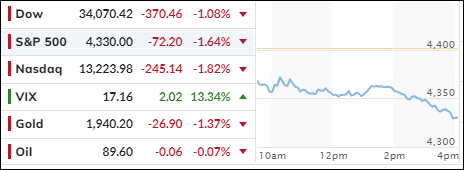
- Moving the markets
The market had a terrible day on Thursday. Stocks fell like rocks, as bond yields soared to levels not seen in years. The Fed is to blame, as it plans to keep raising interest rates and keep them high for a long time. The Fed thinks the economy is too hot and inflation is too high, so it wants to cool things down with higher rates. But the market thinks the Fed is making a mistake and risking a recession.
The Fed’s decision came after a report showed that the job market is still strong, with fewer people filing for unemployment benefits than expected. This means that more people have jobs and incomes, which is good for the economy. But it also means that the Fed has less reason to cut rates, which is bad for the market.
The Fed’s chair, Jerome Powell, tried to calm the market by saying that the economy could still land softly, without crashing hard. But he also said that this was not his main expectation. He sounded like he was not very confident about his own plan.
The market did not like what Powell said, or what he did not say. The market wanted him to say that he would cut rates soon, or at least stop raising them. But he did not say that. He said he would keep raising them and keep them high for longer.
The market reacted by selling stocks and buying bonds. This pushed up bond yields, which are the interest rates that bond investors get. Higher bond yields mean lower bond prices, and lower stock prices too. Higher bond yields also mean higher borrowing costs for businesses and consumers, which can hurt the economy.
The market was already worried about other things, like the housing market slowing down, the manufacturing sector shrinking, and the government shutting down. These things can also hurt the economy and make the market nervous.
The market was so nervous that it broke some important support levels, which are the prices that usually stop the market from falling further. When these levels are broken, the market can fall even more.
Equities fell so much that our Domestic Trend Index turned more negative and gave us a “Sell” signal for domestic equity funds. This means that we should sell these funds tomorrow unless the market bounces back strongly. See section 3 below for more details.
I am doing this to protect our portfolios from losing more value if the market keeps falling. I think it is better to be cautious than reckless in these uncertain times.
Stay tuned.
2. “Buy” Cycle Suggestions
The current Buy cycle began on 12/1/2022, and I gave you some ETF tips based on my StatSheet back then. But if you joined me later, you might want to check out the latest StatSheet, which I update and post every Thursday at 6:30 pm PST.
You should also think about how much risk you can handle when picking your ETFs. If you are more cautious, you might want to go for the ones in the middle of the M-Index rankings. And if you don’t want to go all in, you can start with a 33% exposure and see how it goes.
We are in a crazy time, with the economy going downhill and some earnings taking a hit. That will eventually drag down stock prices too. So, in my advisor’s practice, we are looking for some value, growth and dividend ETFs that can weather the storm. And of course, gold is always a good friend.
Whatever you invest in, don’t forget to use a trailing sell stop of 8-12% to protect yourself from big losses.
3. Trend Tracking Indexes (TTIs)
The market is in bad shape. Both the domestic and the international trend indicators have fallen sharply. The domestic one has gone down even more and entered a bear market. Other indicators also show that the market is weak and may continue to fall. Some important support levels have been broken, which means that there is not much to stop the prices from going lower.
In my advisor practice, I have a plan to deal with this situation. I will sell the domestic equity funds that we own tomorrow unless the market bounces back strongly. Then I will wait for another day to see if the rebound lasts. I am doing this to protect our portfolios from losing more value in case the market crashes. I think it is better to be safe than sorry in these uncertain times.
Of course, there is a chance that the market could turn around and go up again. But I am willing to take that risk. If that happens, I can always buy back the funds later. But at least I will have avoided the worst-case scenario of losing a lot of money in a market meltdown.
This is how we closed 09/21/2023:
Domestic TTI: -1.86% below its M/A (prior close -0.20%)—Buy signal effective 12/1/2022.
International TTI: +1.91% above its M/A (prior close +3.20%)—Buy signal effective 12/1/2022.
All linked charts above are courtesy of Bloomberg via ZeroHedge.
Contact Ulli